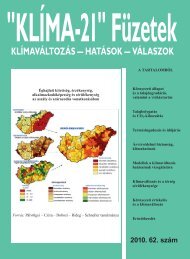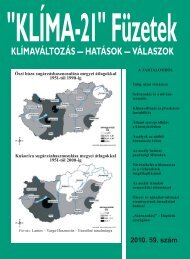KLÃMA-21 Füzetek 61. szám - VAHAVA Hálózat
KLÃMA-21 Füzetek 61. szám - VAHAVA Hálózat
KLÃMA-21 Füzetek 61. szám - VAHAVA Hálózat
You also want an ePaper? Increase the reach of your titles
YUMPU automatically turns print PDFs into web optimized ePapers that Google loves.
„KLÍMA-<strong>21</strong>” FÜZETEK: KLÍMAVÁLTOZÁS – HATÁSOK – VÁLASZOK 193<br />
AGROTECHNOLOGICAL TASKS RELATED TO PERIODS OF EXTREME<br />
PRECIPITATION<br />
By<br />
NEMÉNYI, MIKLÓS – MILICS, GÁBOR –<br />
KOVÁCS, ATTILA JÓZSEF – SITKEI, GYÖRGY<br />
Keywords: intensive rainfall, high water table, soil mechanics, hydrology,<br />
agrotechnological interventions.<br />
In our opinion, the problem of periods with extreme precipitation could be remedied at a<br />
cost which is lower by magnitudes than the losses sustained. One thing is certain: the principle<br />
of „Think globally, act locally” is applicable here as well. In this case, „local” refers to<br />
countering detrimental effects on or below plot level.<br />
Experience so far indicates that areas with high water table need to be addressed as a separate<br />
category with respect to the selection of species, varieties and hybrids as well as in terms<br />
of production technology and agrotechnology, allowing for the fact that environmental effects<br />
are decisive for both aspects.<br />
At the same time, modern geospatial information systems are now essential in recording<br />
data about both crops and soil and in carrying out the necessary monitoring tasks. On the<br />
other hand, it remains necessary to adopt and improve methodologies for the online recording<br />
of physical and chemical characteristics of soil. The resulting databases could in the future<br />
contribute to replacing physical detection methods with satellite-based (hyperspectral) ones.<br />
Additionally, we are convinced that the procedures and modelling methodology presented<br />
in the paper can significantly contribute to designing a comprehensive national research<br />
project which would provide local, plot-level answers to yet unresolved practical issues.<br />
ENVIRONMENTAL SOIL TILLAGE (3E) AND MACHINERY<br />
– A RESPONSE TO CLIMATE CHANGE<br />
By<br />
JÓRI J., ISTVÁN<br />
Keywords: sustainability, climate change, soil tillage, machinery.<br />
One of the essential components of sustainable development is the rational use and protection<br />
of our most important natural resource, the soil, as well as the preservation of its versatile<br />
functions. This is one of the most important tasks common to environmental protection and<br />
agriculture. Soil and the environment mutually affect each other. For one, soil „suffers” the often<br />
detrimental stress occurring in the environment, but it may also be the cause of such stress<br />
– primarily if used incorrectly – and give rise to threats to other components of the environment,<br />
such as the underground and aboveground waters, the atmosphere near the ground, the flora<br />
and fauna, as well as the landscape. The solution lies in the environmental soil tillage system.






